MARIANI’S
Virtual Gourmet
July 30, 2017
NEWSLETTER

Portuguese
Travel Poster by Alberto de Souza (circa 1959)
IN THIS ISSUE
ANGUILLA, Part One
By John Mariani
NEW YORK CORNER
SESSANTA
By John Mariani
NOTES FROM THE WINE CELLAR
THE TRUE CHARM OF BEAUJOLAIS
By John Mariani
❖❖❖
ANGUILLA, Part One
By John Mariani

Beachside Dinner at Cap Juluca
As annoying as the trip from any airport to one’s destination always is, the hiatus provided by taking a short
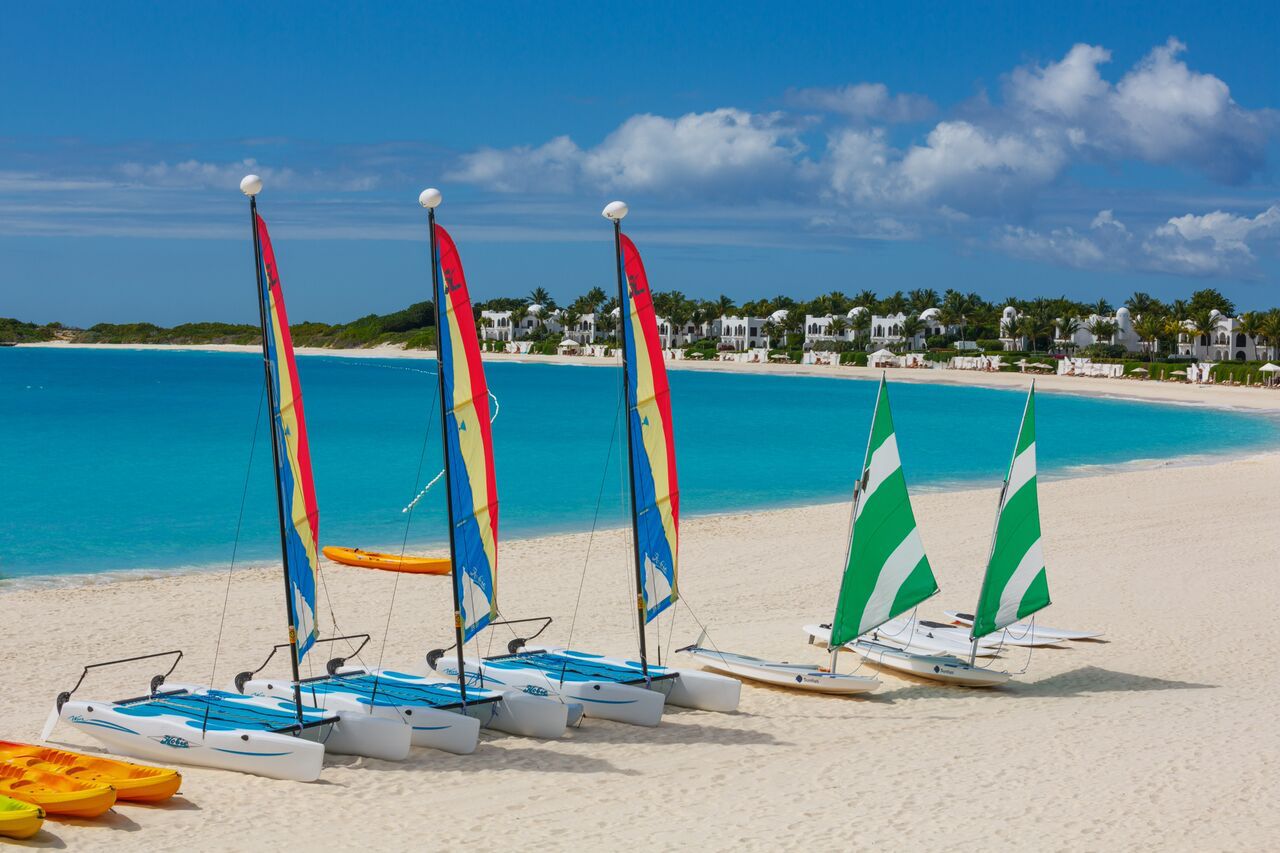 boat trip
to an island is never less than
inspiriting. The loading of the baggage, the
start-up of the motorboat, the
bouncing along the sea and the usual offer of a
beer or punch conspire with
the wind and the salt air both to calm the
stresses of the plane ride and airport
passage and to remind you that you will soon
arrive in a different world.
boat trip
to an island is never less than
inspiriting. The loading of the baggage, the
start-up of the motorboat, the
bouncing along the sea and the usual offer of a
beer or punch conspire with
the wind and the salt air both to calm the
stresses of the plane ride and airport
passage and to remind you that you will soon
arrive in a different world.In the case on Anguilla my wife and I boarded a fast-moving boat at the St. Maarten Ferry Terminal on a choppy cerulean blue sea and disembarked on the island to grab a taxi to our resort, Cap Juluca on Maundays Bay, spread over two curving coves with a mile-long white-sand beach (right). As one of the island’s first luxury properties, Cap Juluca (named for the rainbow spirit of the original Arawak Indians) opened in 1984 and set a very high standard, not least in personal service of a kind still rare in the Caribbean.
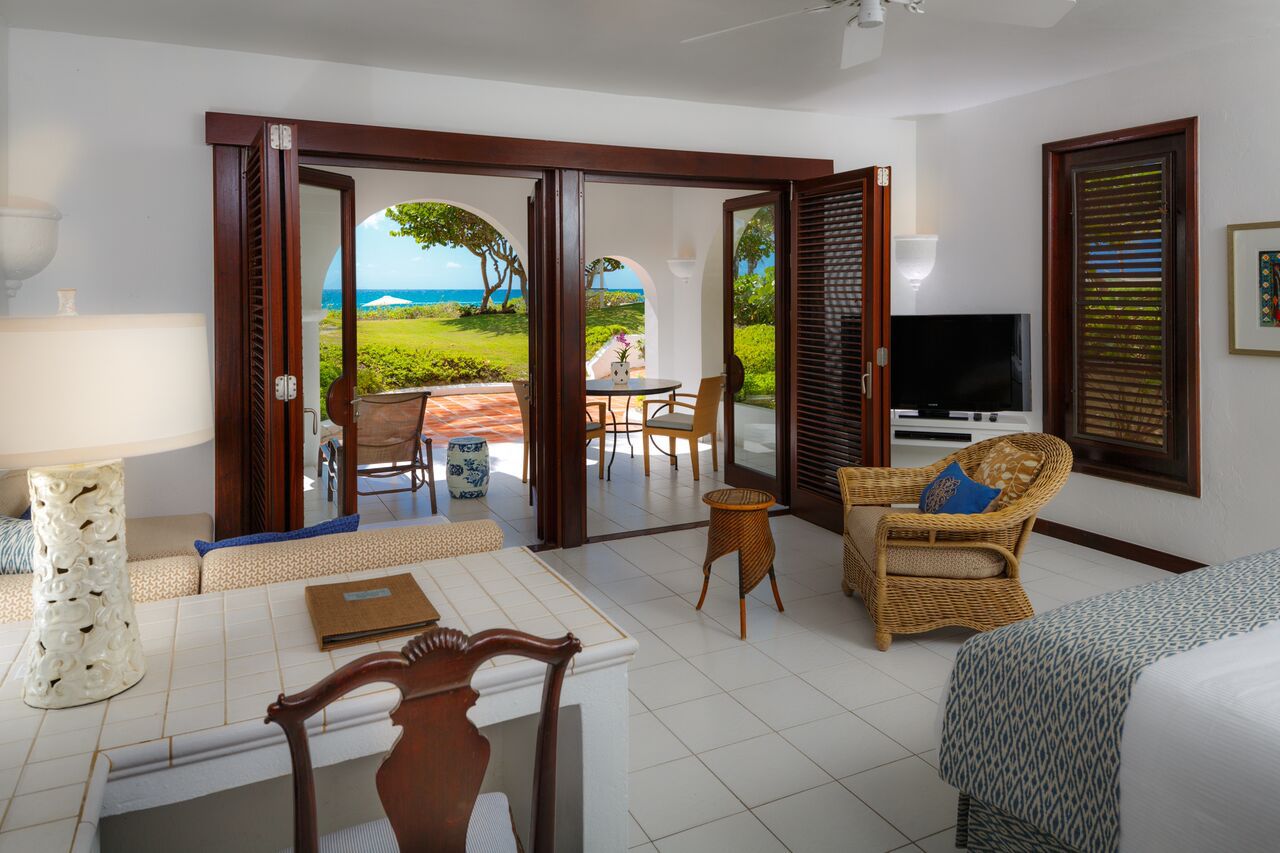 The
choice of the property’s whitewashed Greco-Moorish
architecture was
also a radical break from the ordinary resort style,
and the spaciousness of
the 95 apartment-like rooms, with louvered shutters
and state-of- the-art bathrooms,
make each unit quite separate from another. There
are also some extraordinary
private pool villas than run up to 5,200 square feet
in size. Add
in the resort’s location being a good distance from
the road and its seclusion
becomes one of its principal allures.
The
choice of the property’s whitewashed Greco-Moorish
architecture was
also a radical break from the ordinary resort style,
and the spaciousness of
the 95 apartment-like rooms, with louvered shutters
and state-of- the-art bathrooms,
make each unit quite separate from another. There
are also some extraordinary
private pool villas than run up to 5,200 square feet
in size. Add
in the resort’s location being a good distance from
the road and its seclusion
becomes one of its principal allures.The resort was run for three decades by Charles and Linda Hickox, who just this year sold it to the London-based Belmond Ltd., which expects to close it in January and renovate the property, so what I say here about specific restaurants and cuisine may in fact change when it re-opens. Plans are for 25 new villas or suites, increasing the number of rooms to 121 by the end of 2018.
For now, there are several dining spots on property, all drawing as much as possible from the resort’s own gardens. Pimms is Cap Juluca’s fine dining restaurant, romantically lighted, with a civilized bar and, of
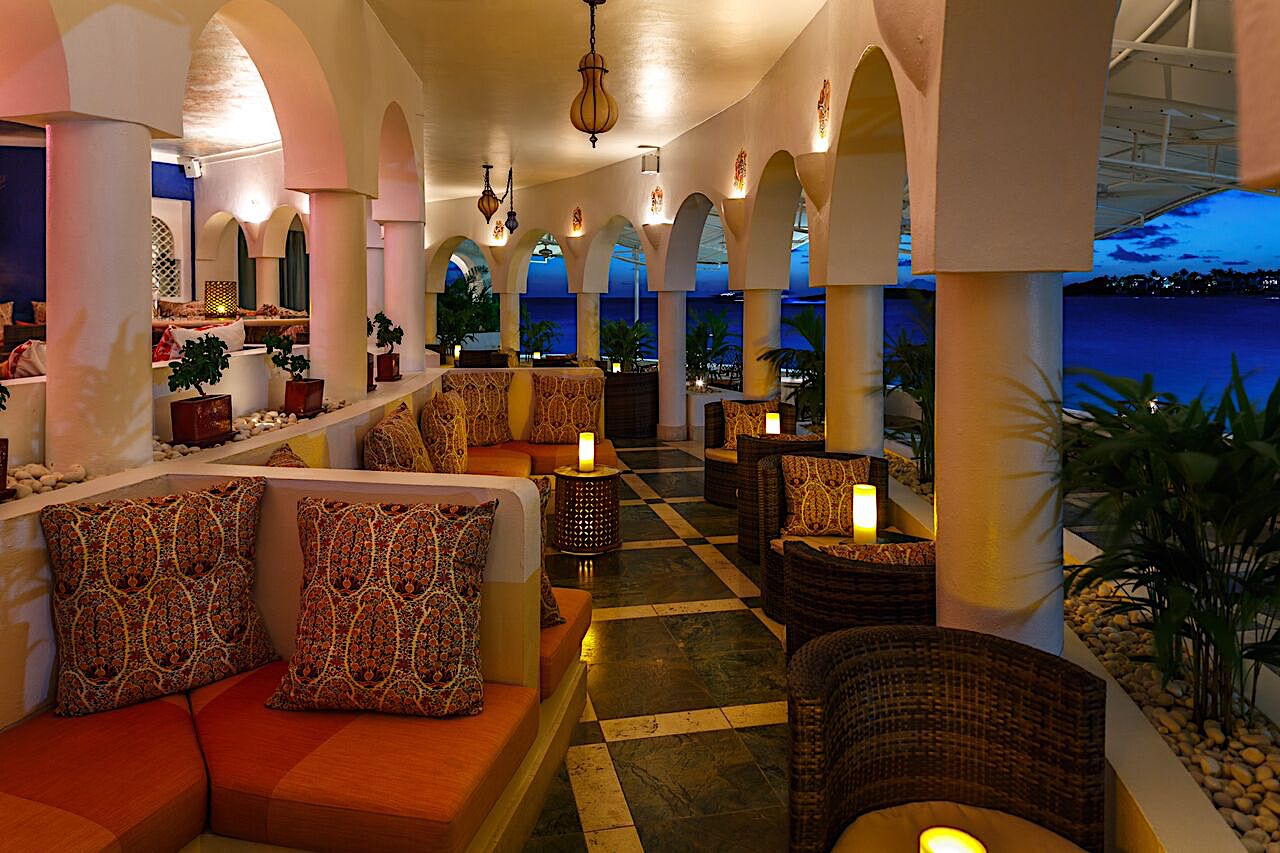 course, a panorama on the
sea that makes it as beautiful
at twilight as under moonlight. The wine list is one
of the best in the
Caribbean and the Wine Room may be taken for private
parties with a five-course
meal and paired bottlings.
course, a panorama on the
sea that makes it as beautiful
at twilight as under moonlight. The wine list is one
of the best in the
Caribbean and the Wine Room may be taken for private
parties with a five-course
meal and paired bottlings.It should be noted that getting the best seafood out of the Caribbean is not as reliable as anyone would like, for Anguilla does not have a commercial fishing industry, so buyers must rely on individual fisherman to show up when they choose. One goes out on Tuesday, another on Wednesday, some stay home when they feel like it. One fishes for grouper, another for mahi-mahi, another for lobster. So few menus on the island offer more than two or three species.
Having said that, my wife and I enjoyed the some of the finest quality seafood we’ve had in the Caribbean at Pimms, right on the beach itself at a candlelighted, linen-draped table on a starry, cloudless night. We began with a nice, chunky tuna tartare (below), then big eye snapper with Asian spicings, then impeccably broiled lobster, accompanied by well-chilled wine
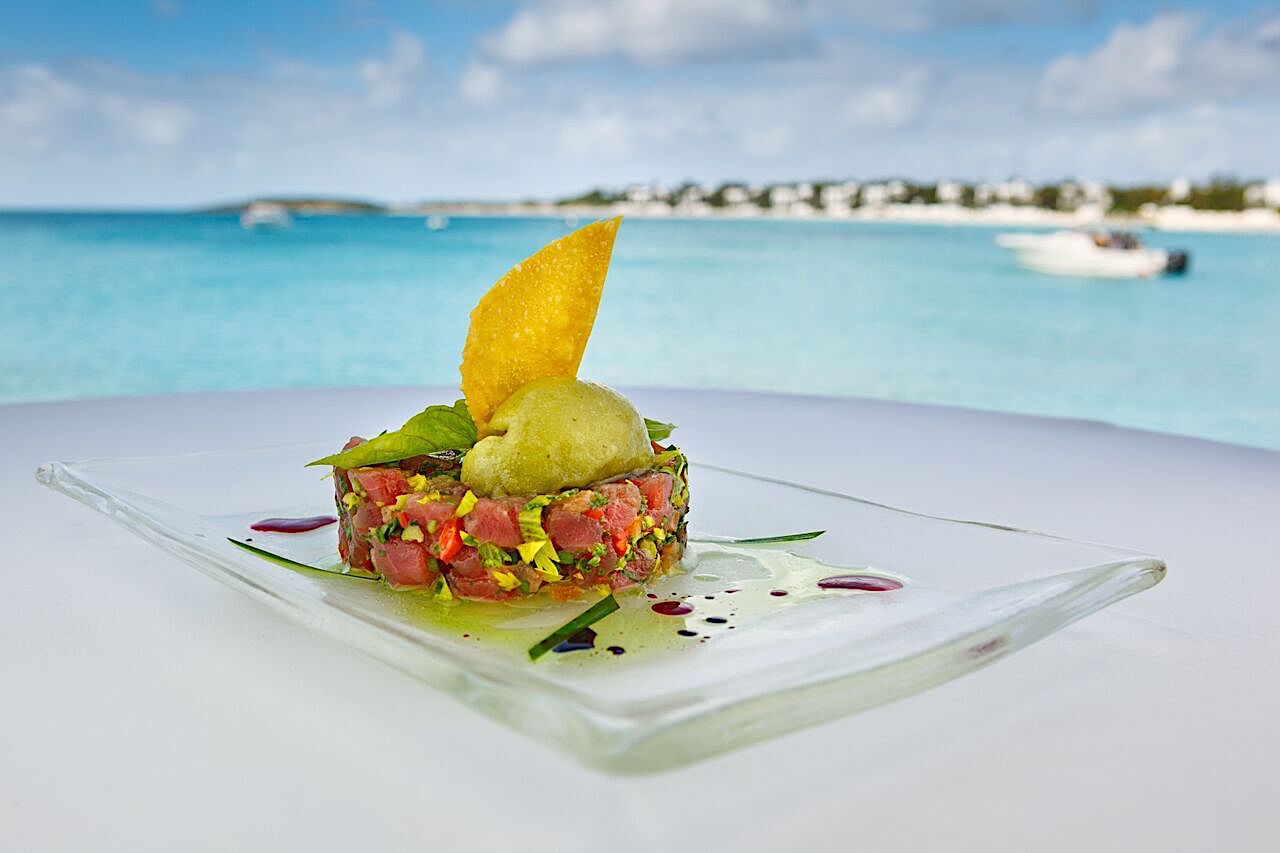 from that superlative
list. It seemed a good idea to have a well-aged rum
at evening’s end.
from that superlative
list. It seemed a good idea to have a well-aged rum
at evening’s end.Also at Cap Juluca, Blue (below) is a casual patio eatery used for a buffet breakfast and light bites like conch fritters and mahi-mahi wraps, while Spice (above) is a cocktail lounge with small plates. Afternoon tea is served at Maundays.
Anguilla is a flat island without the kind of mountains like on Martinique that attract the great thunderclouds. Anguilla is very dry, in fact,
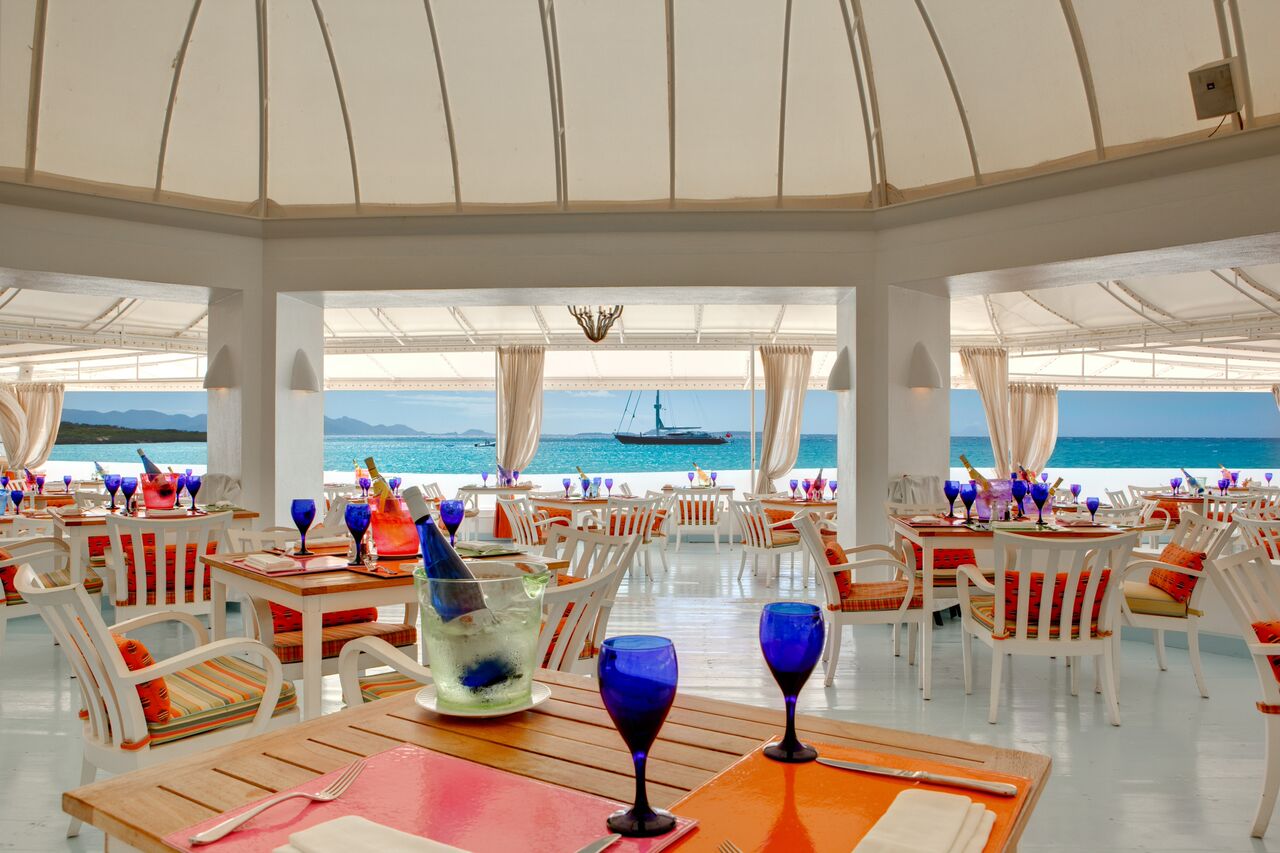 and hurricanes
are a rarity—the last big blow was Luis in 1995. Its
coral is protected,
and there are laws against residents leaving
unsightly, rusting furniture
or old cars on their property—a blight that plagues
other islands.
and hurricanes
are a rarity—the last big blow was Luis in 1995. Its
coral is protected,
and there are laws against residents leaving
unsightly, rusting furniture
or old cars on their property—a blight that plagues
other islands.There is evidence of the Zika virus, which continues to hurt tourism,though to a lesser extent than many other islands. And while Anguilla has not entirely recovered from the 2009 recession, the tour boat business is booming and boat racing is now a huge enterprise here.
 I
had lunch with the Honorable Cardigan Connor,
Parliamentary Secretary
for Tourism, Sports, Youth and Culture, who told me,
“Anguilla is really
still a village. Most property is still owned by the
locals, even though the
governor is always British. Sadly, there has been a
mass emmigration abroad
to seek work, but there has always been a remnant of
citizens who act as
an anchor to preserve the culture here.”
I
had lunch with the Honorable Cardigan Connor,
Parliamentary Secretary
for Tourism, Sports, Youth and Culture, who told me,
“Anguilla is really
still a village. Most property is still owned by the
locals, even though the
governor is always British. Sadly, there has been a
mass emmigration abroad
to seek work, but there has always been a remnant of
citizens who act as
an anchor to preserve the culture here.”Only recently have any serious attempts begun to grow fruits and vegetables on Anguilla, whose arid climate is difficult. One of the most promising developments in agriculture is Sensational Flavors, an agro-tourism venture opened last year in Mount Fortune. There the passionately committed founder Salih Abdur Raheem (left) and his cousin, Owen, have planted food plants most doubted could ever grow on the island, and the enterprise is supported by a weekend market tent selling the farm’s organic wares as well as drinks and fried fish. “I don’t do this for the money,” says Raheem. “It is a passion for me that I hope someday will make profits. I wanted to prove that it can be done and should be copied.”
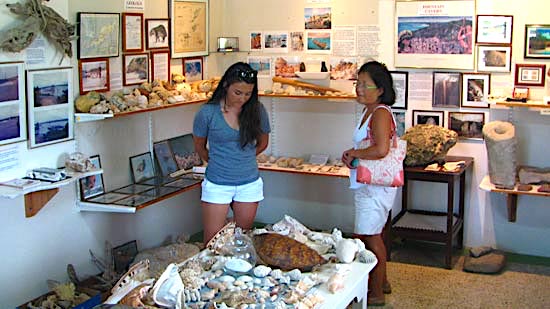
Of particular interest to visitors digging into the island’s history is the Anguilla Heritage Collection (right), whose devoted owner, Colville Perry, shows off artifacts dating to the Arawak era and seafaring days, continuing on to the colonial and post-colonial days. Perry remembers the days when Anguillans drank brackish water for lack of fresh sources.
The island itself is dotted with historic structures as part of Anguilla’s National Trust and includes the quaintly eccentric St. Gerard’s Catholic Church in the Valley, a small parish whose original church was destroyed in a hurricane in 1961 and, along with a conference center, rebuilt into three Gothic arches composed of island stones with a red door.
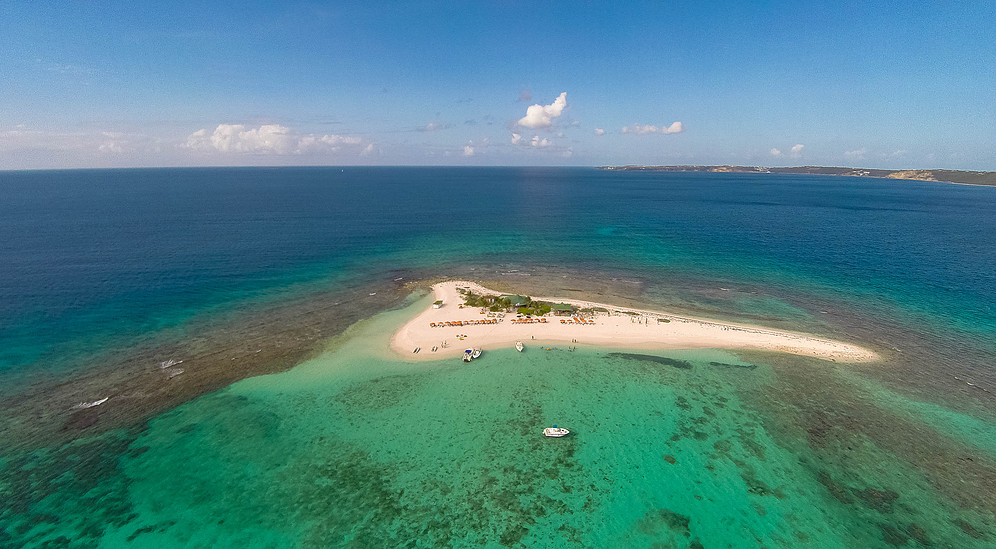 One
of the best ways to appreciate Anguilla is to sail
away from it on a
shuttle called “Happiness” to Sandy Island
($10 round-trip). First opened in 1984,
the little boomerang-shaped isle (left) has been
rebuilt every time a storm has blown it away,
but for the time being it functions as a very
popular thatched roof barbecue
grill complete with live music and steel drums. You
can bake in the
snow-white sand or sit back under the roof and drink
JoJo’s all-too-easy
rum punch while feasting on a menu of baby back
ribs, drunken coconut
shrimp, spicy shrimp kebabs, and grilled lobster
with coconut and ginger
sauce.
One
of the best ways to appreciate Anguilla is to sail
away from it on a
shuttle called “Happiness” to Sandy Island
($10 round-trip). First opened in 1984,
the little boomerang-shaped isle (left) has been
rebuilt every time a storm has blown it away,
but for the time being it functions as a very
popular thatched roof barbecue
grill complete with live music and steel drums. You
can bake in the
snow-white sand or sit back under the roof and drink
JoJo’s all-too-easy
rum punch while feasting on a menu of baby back
ribs, drunken coconut
shrimp, spicy shrimp kebabs, and grilled lobster
with coconut and ginger
sauce. Across the water is little Anguilla, which somehow seems so big when you’re on an islet so small. As long as the punch holds out, it’s a tough place to leave.
❖❖❖
By John Mariani
It should have been a
45-minute
drive from my house to SoHo, but because
of traffic from the moment I left straight
through to
getting entangled in the commuter rush to
squeeze through the Holland Tunnel,
that trip took me two agonizing hours,
expletives included throughout.
When my wife and I staggered
into the restaurant, to be seated on the patio
on a perfect summer’s night and find my friends
waiting, I was exhausted and still enraged.
Then, after some kind words from the
owner and manager Gina deMasi and the timely
delivery of a perfectly made daiquiri,
everything that had occurred before vanished
into
nothingness. I was so happy again. The two-year-
old Sessanta seems to have that
effect on a lot of people.
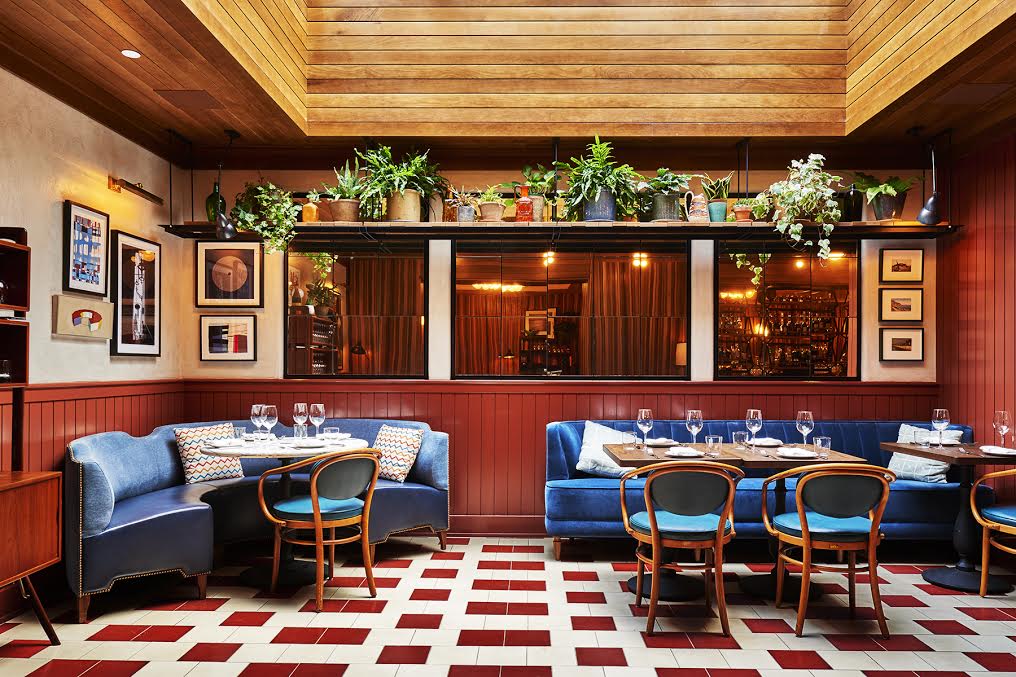 The space, in Sixty
Soho Hotel,
had long been a shadowy Thai restaurant, but its
transformation into a Southern Italian style
with
striped maple walls, sky blue couches, colored
tile floors and a skylight
above the main dining area has changed the
ambiance to something more welcoming.
The space, in Sixty
Soho Hotel,
had long been a shadowy Thai restaurant, but its
transformation into a Southern Italian style
with
striped maple walls, sky blue couches, colored
tile floors and a skylight
above the main dining area has changed the
ambiance to something more welcoming.
Owner John McDonald, who also
runs Lure Fishbar nearby, originally had a
Sicilian-born chef, but his
replacement, Adam Leonti, from Italian
background and raised in Maine, has maintained
many of the
Mediterranean flavors on his menu while scouring
the rest of Italy for good ideas. One delectable
item but from
Valtellina is gli
sciatt ($14), a kind of ravioli in a
sour beer batter and containing bitto
cheese, pomegranate
and pear; its crisp shell crunches to reveal all
that gooey goodness
inside. Farinata,
a chickpea pancake (burnt that night) served
with asparagus, smoked salmon ($15,) is a
Ligurian specialty. The artichoke lasagne
($16) was Roman-inspired, with mint, parsley and
lemon, while quail was more Lombardian for being
accompanied by foie gras, and touched with sweet
melon and summer’s zucchini flower ($18).
Every one of the pastas I
tried
was very good to excellent, both in form and
cooking texture. Tagliatelle with a Genovese
basil pesto
($17) was pleasingly traditional (right),
while lasagne
verde was layered with an admirable—for
once!—ragù
bolognese and béchamel ($19). Braised
rabbit plumped up savory Ligurian fazzoletti crȇpes
($19); conchiglione
was a
large pasta shell filled with four ounces of
lobster in its own shell,
lavished with a rich sauce americaine ($22)—a
sloppy plate but very good.
So, too, Leonti’s way with
brook trout is not pretty but it’s one of
the best renditions I’ve had of this freshwater
fish ($26), served with
wax beans, cockles and lemon—an outstanding
dish. Saltimbocca, usually made with veal that
doesn’t taste like much, is here made with
pounded chicken,
a slice of prosciutto and sage ($28) served with
soft polenta and braised “Tuscan kale” (true cavolo nero
is close to kale).
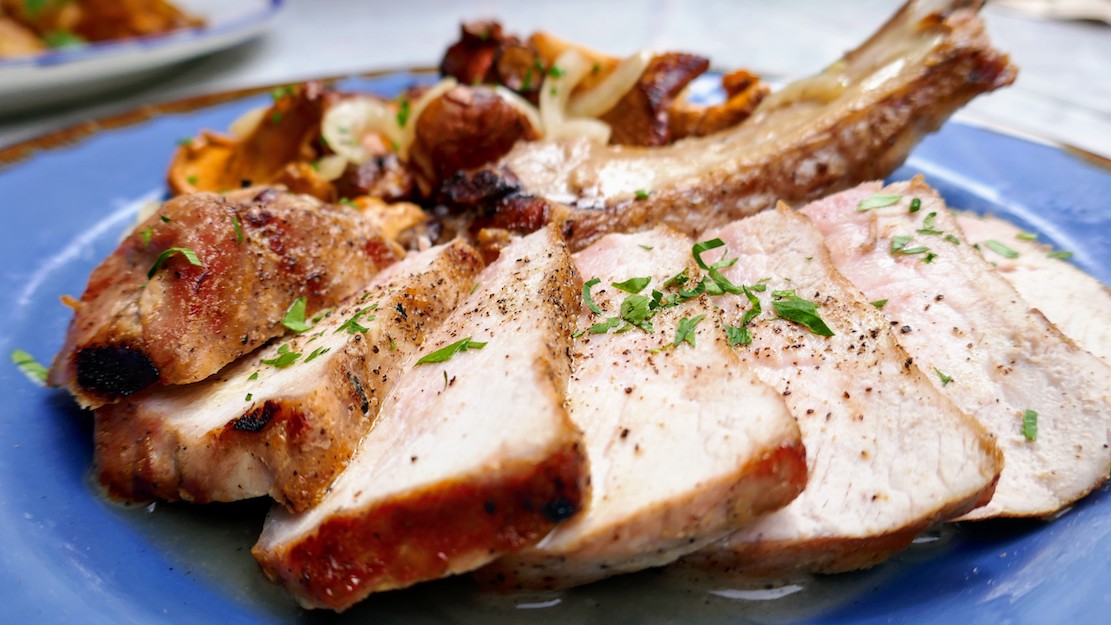 Nicely
crisp outside with a good
rosy flesh, grilled duck breast took on the
sweet-sour accents of cherry and a bitter onion
agrodolce to
fine effect ($32), and Leonti has clearly
acquired a good pork supplier,
for Sessanta’s grilled pork chop was juicy and
had a good amount of fat
($32), served with chanterelles and baby onions.
On the side I enjoyed the
very Roman dish of crisply fried artichokes alla giudia
($12), good for the
table to share (below).
Nicely
crisp outside with a good
rosy flesh, grilled duck breast took on the
sweet-sour accents of cherry and a bitter onion
agrodolce to
fine effect ($32), and Leonti has clearly
acquired a good pork supplier,
for Sessanta’s grilled pork chop was juicy and
had a good amount of fat
($32), served with chanterelles and baby onions.
On the side I enjoyed the
very Roman dish of crisply fried artichokes alla giudia
($12), good for the
table to share (below).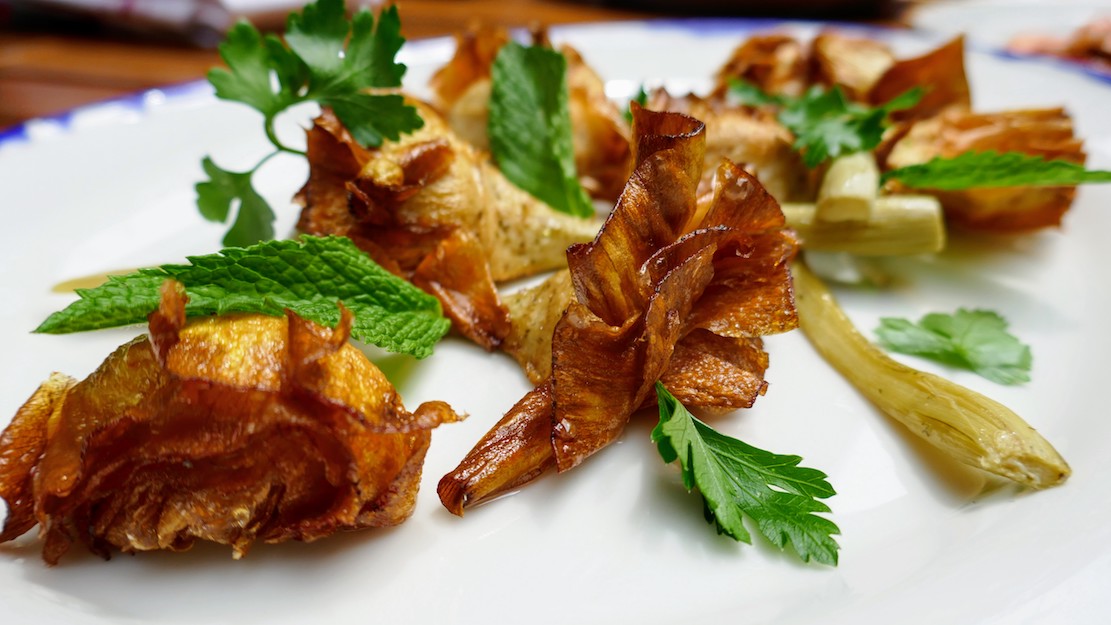
Desserts ($12) are simple in
the
best Italian sense: Lemon tart with blueberry
Prosecco sauce; panna cotta with ginger cookie
and
raspberries; a flourless chocolate cake with
strawberry balsamic gastrique; and sheep’s milk
ricotta cake with burnt caramel.
Sessanta offers a whole page
of
cocktails, beers, and wines by the glass. Young
sommelier Colin Burke is still building his wine
list, so
he’s a good man to trust to help choose a wine
to go with your food and
according to your budget.
Were Sessanta just a tiny
Soho
storefront serving the kind of
out-of-the-ordinary food Leonti does, it would
be well worth any Italian food lover’s while.
But the fact that it’s a casually elegant spot
with one
of the more appealing patios in a less frenetic
part of Manhattan puts it a
lot closer stylistically to Milan than it does
to NYC.
Sessanta is open nightly for dinner;
Caffe Sessanta is open for
breakfast and lunch daily.
❖❖❖
By John Mariani

As
summer red wines go, I think that correctly
aged Beaujolais is easily
the most versatile match for summer foods. I
say “correctly aged” because
Beaujolais still labors among some wine
drinkers under the outdated fad
for Beaujolais Nouveau, which crested more
than a decade ago, as well as
a misguided notion that Beaujolais is little
more than a cheap, low-alcohol wine
drunk in house carafes throughout France.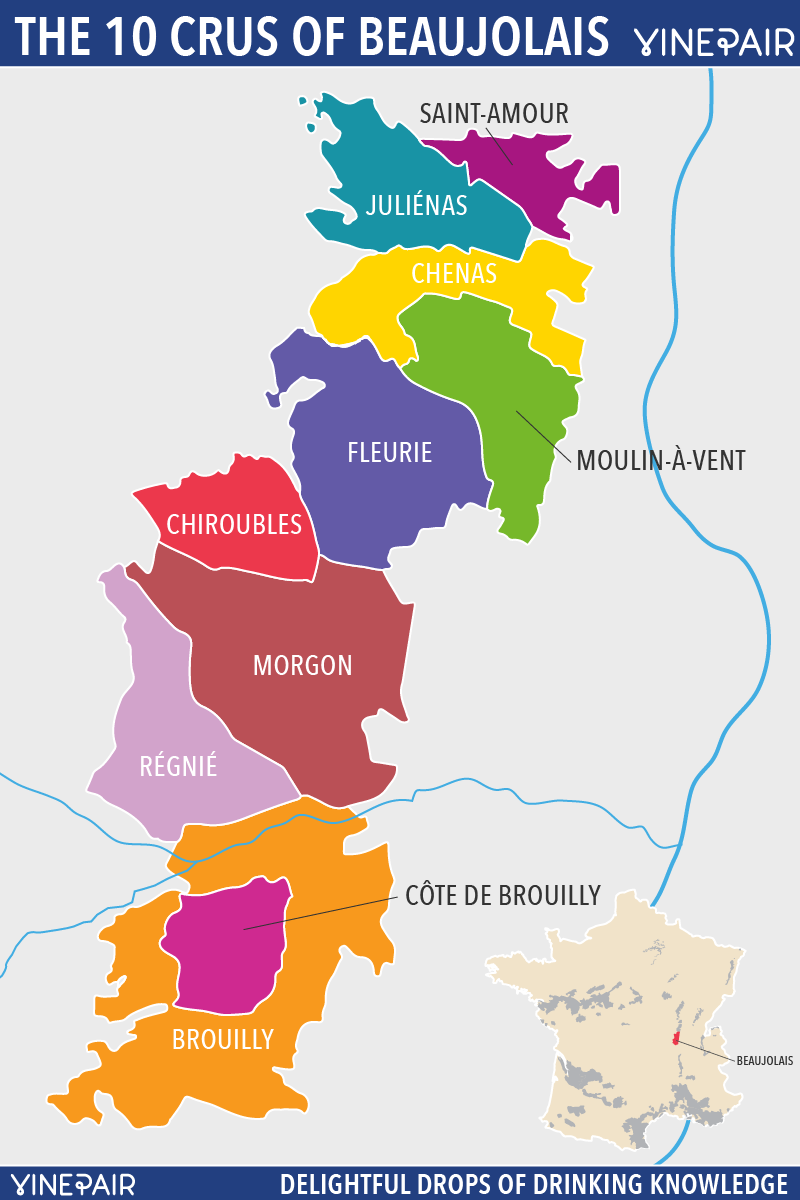
There
was considerable truth to the idea that most
Beaujolais used to be
produced in bulk from Gamay Noir grapes for the
bistro market, drawn from
more than 55,000 acres in Southern Burgundy and
sold by distributors called
negoçiants. But
since the 1990s the better Beaujolais have come
from vineyards brought
to modern standards of viticulture, especially
in those appellations granted
status as Beaujolais-Villages, whose wines must
have a minimum of 10
percent alcohol and now constitute about
one-quarter of total production.
Overall
the region produces about 13 million cases of
Beaujolais annually. The
best Beaujolais, whose alcohol tilts more
towards 13 percent, come from
ten regulated crus—Brouilly, Chénas, Chiroubles,
Côte de Brouilly, Fleurie,
Juliènas, Moulin-à- Vent, Morgon, Saint-Amour,
and Régnié—usually
costing between $10-$15 a bottle. By common
agreement, Beaujolais
Nouveau cannot be made from these crus.
Distancing
themselves from the Beaujolais Nouveau hysteria
has become
an important marketing point for the crus. The
crus most certainly improve with age, but age is
relative; the crus develop
best at two to three years old. After that many
become risky, either losing
their fruit or tasting muddled. Some aficionados
claim that some ten-year-old
Beaujolais show amazing complexity, but very few
connoisseurs would
bother to cellar Beaujolais for such lengths of
time.
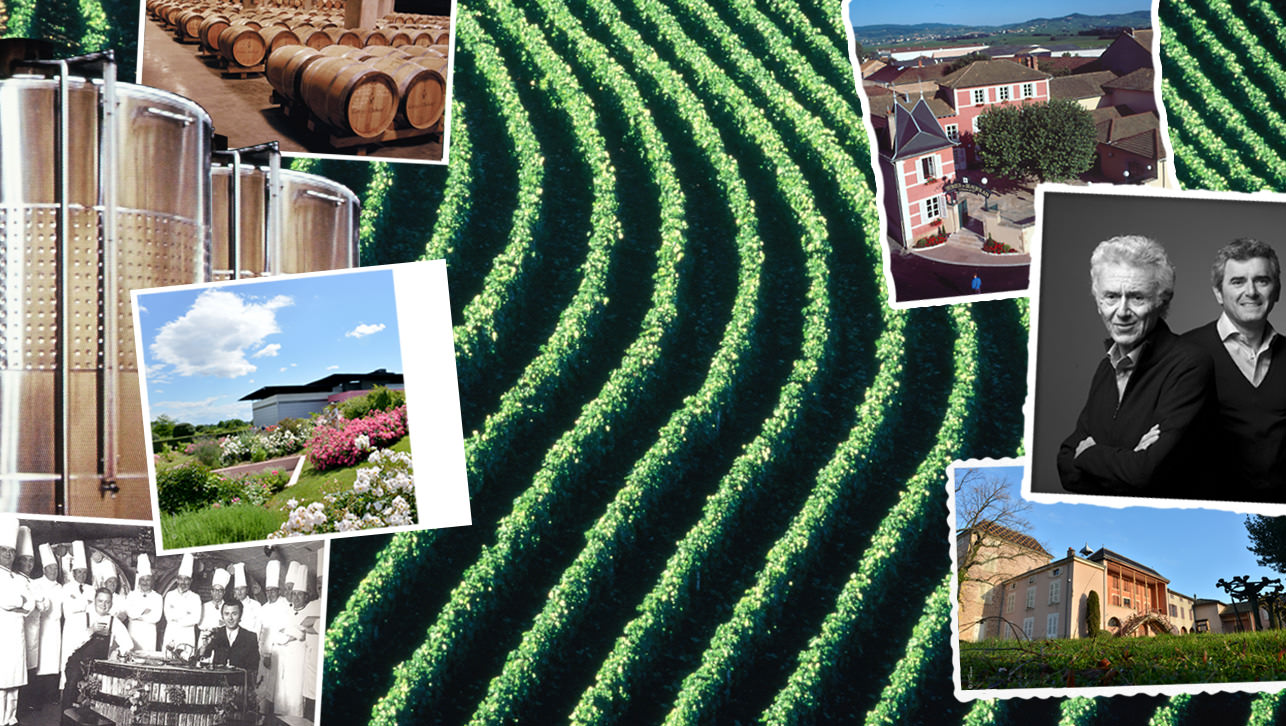 By
far the largest negoçiant, who is sometimes
called the “King of Beaujolais” (left)
is Georges DuBouef, 84, who still ships 2.5
million cases annually. Over
a week of home-cooked meals I found most of the
Beaujolais tasted—all
from the 2016 and 2015 vintages—had
characteristic Gamay charm, which means
a little spicy, a great deal of fruit, and an
alcohol level that rarely goes above
13%.
By
far the largest negoçiant, who is sometimes
called the “King of Beaujolais” (left)
is Georges DuBouef, 84, who still ships 2.5
million cases annually. Over
a week of home-cooked meals I found most of the
Beaujolais tasted—all
from the 2016 and 2015 vintages—had
characteristic Gamay charm, which means
a little spicy, a great deal of fruit, and an
alcohol level that rarely goes above
13%.
Brouilly
is almost always a crowd pleaser, with good
body, plenty of flower
scents in the nose, and an earthy vibrancy of
fruit that knits it all into good
balance—an ideal wine with grilled salmon or a
terrine of foie gras on toasted
country bread. Domaine du Riaz ($19.99) was also
delicious with mild
cheeses, much better than a bigger, bolder red.
Domaine
Pontheux ($18.99) is a Chiroubles,
lighter than Brouilly but with
more complexity than Fleurie wines. You smell
lavender and violets in the
nose, and it’s the kind of wine that goes well
with charcuterie dabbed with
a little mustard and accompanied by gherkins. It
adds to those flavors and
this domaine draws from 50-year-old vines that
give more structure to the
wine.
with
more complexity than Fleurie wines. You smell
lavender and violets in the
nose, and it’s the kind of wine that goes well
with charcuterie dabbed with
a little mustard and accompanied by gherkins. It
adds to those flavors and
this domaine draws from 50-year-old vines that
give more structure to the
wine.
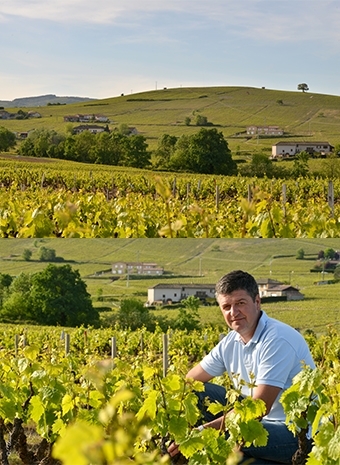 Juliénas
is considered one of the better regions for
aging Beaujolais, and
Chȃteau des
Capitiane 2015 ($21.99) demonstrates
the truth of that opinion.
The vines at this chȃteau date back at least
half a century and the hillsides
get a lot of sun, giving the wine 14% alcohol
and more complexity. Some
of the wine spends 8 months in oak, unusual for
Beaujolais, so on a warm
night it takes very well to just about anything
off the grill, not least a nicely
fatted veal chop we enjoyed that night.
Juliénas
is considered one of the better regions for
aging Beaujolais, and
Chȃteau des
Capitiane 2015 ($21.99) demonstrates
the truth of that opinion.
The vines at this chȃteau date back at least
half a century and the hillsides
get a lot of sun, giving the wine 14% alcohol
and more complexity. Some
of the wine spends 8 months in oak, unusual for
Beaujolais, so on a warm
night it takes very well to just about anything
off the grill, not least a nicely
fatted veal chop we enjoyed that night.
Morgon
can be among the heartiest of Beaujolais cru,
and Domaine de
Javernières Côte du Puy 2016 ($19.99;
left)
produces only 400 cases. The tannins are
now loosening up, revealing the dark fruit of
Gamay and a richness that makes
it a great match for marinated lamb dishes with
herbs like rosemary. In
much the same style, Jean Ernest Descombes 2015 ($21.99),
with its extra year
of age, manifests a terroir rich in minerals, so
it’s a good match-up with pork,
sausages, and hot dogs in summer. Another
night my dinner was seared and roasted veal
chops, cooked pink,
and with this the Morgon ($11.95) stood out for
its bold Beaujolais spirit
and its ability to age well, still with soft
tannins and creamy fruit flavors.
Moulin-à-Vent
(below),
whose name refers to the windmills in the area,
is often considered the best of the crus, though
this varies
widely depending on the estate and negoçiant.
DuBouef buys his from
Domaine des
Rosiers, and the 2015 costs $23.99, on
the high side of Beaujolais
prices. But the body, the complexity, and the
softness of the wine
puts it in strong competition with more famous
red Burgundies of the Côte
d’Or, so that you might mistake it for a
Mercurey or Fixin, which means
a well-seared sirloin is going to taste even
better when married to this Moulin-à-Vent.
As
for Fleurie, I think they are likeable wines,
light, undemanding and better
as an aperitif or with a summer salad. The 2015 Clos des
Quatre Vents
($21.99) gained from aging, and the granite soil
of the vineyard gives it
a bit more interest than other Fleuries.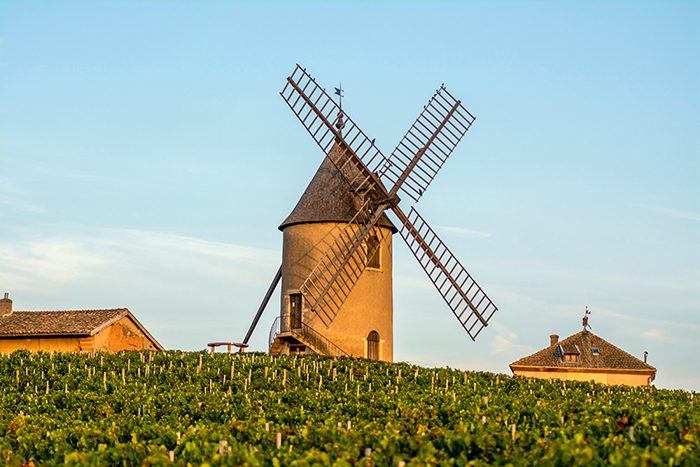
A Chiroubles was the driest
of my sampling, showing the minerality
of its 1,200-foot hillside altitude and granite
soil and the richness of
even some mightier Burgundian pinot noirs. The
Georges Duboeuf Flower Label wine line includes Saint-Amour
($13.49) and the Chenas ($12.49) were very
feminine compared
with the heft of a Chiroubles ($12.49) and
Julienas ($12.95). I scribbled
“gamine” on the Saint-Amour label, the very
well-fruited cherry-like
soul of Gamay at its best, a wine that could be
served with anything from
pork to roast chicken, which was stuffed under
the skin with herb butter.
The Chenas—supposedly Louis XIII’s favorite
wine—was more complex
than one might think about Beaujolais, with
plenty of the village’s ripe
fruit atop spicy, green flavors.
I
wasn’t very fond of the Julienas, whose
unimpressive, flat bouquet was
followed by a one-dimensional metallic flavor I
don’t think would be a match
for many foods above the hamburger level.
For those not aware of
the range of aged Beaujolais cru, summer is a
good time to try them all and find how diverse
they really are.
❖❖❖
HOW DO YOU
SAY "OOPS!" IN MANDARIN?
A 26-year-old woman
in China (right)
trying to make a live stream video for the
Internet about the health benefits of eating aloe
vera leaves was poisoned and hospitalized after
she consumed the wrong kind of plant.

“At times, Italienne
is like somebody who starts to tell you a joke about a
priest, a rabbi and an imam in a rowboat and ends up
talking about Maimonidean law.”--Pete Welles,
“Italienne,” NY Times
(5/24/17)
Any of John Mariani's books below may be ordered from amazon.com.
 The
Hound in Heaven (21st Century Lion Books)
is a novella, and for anyone who loves dogs,
Christmas, romance, inspiration, even the supernatural, I
hope you'll find this to be a treasured favorite.
The story concerns how, after a New England teacher,
his wife and their two daughters adopt a stray puppy found
in their barn in northern Maine, their lives seem full of
promise. But when tragedy strikes, their wonderful dog
Lazarus and the spirit of Christmas are the only things
that may bring his master back from the edge of
despair.
The
Hound in Heaven (21st Century Lion Books)
is a novella, and for anyone who loves dogs,
Christmas, romance, inspiration, even the supernatural, I
hope you'll find this to be a treasured favorite.
The story concerns how, after a New England teacher,
his wife and their two daughters adopt a stray puppy found
in their barn in northern Maine, their lives seem full of
promise. But when tragedy strikes, their wonderful dog
Lazarus and the spirit of Christmas are the only things
that may bring his master back from the edge of
despair. WATCH THE VIDEO!
“What a huge surprise turn this story took! I was completely stunned! I truly enjoyed this book and its message.” – Actress Ali MacGraw
“He had me at Page One. The amount of heart, human insight, soul searching, and deft literary strength that John Mariani pours into this airtight novella is vertigo-inducing. Perhaps ‘wow’ would be the best comment.” – James Dalessandro, author of Bohemian Heart and 1906.
“John Mariani’s Hound in Heaven starts with a well-painted portrayal of an American family, along with the requisite dog. A surprise event flips the action of the novel and captures us for a voyage leading to a hopeful and heart-warming message. A page turning, one sitting read, it’s the perfect antidote for the winter and promotion of holiday celebration.” – Ann Pearlman, author of The Christmas Cookie Club and A Gift for my Sister.
“John Mariani’s concise, achingly beautiful novella pulls a literary rabbit out of a hat – a mash-up of the cosmic and the intimate, the tragic and the heart-warming – a Christmas tale for all ages, and all faiths. Read it to your children, read it to yourself… but read it. Early and often. Highly recommended.” – Jay Bonansinga, New York Times bestselling author of Pinkerton’s War, The Sinking of The Eastland, and The Walking Dead: The Road To Woodbury.
“Amazing things happen when you open your heart to an animal. The Hound in Heaven delivers a powerful story of healing that is forged in the spiritual relationship between a man and his best friend. The book brings a message of hope that can enrich our images of family, love, and loss.” – Dr. Barbara Royal, author of The Royal Treatment.
 |
The Encyclopedia of American Food and Drink by John F. Mariani (Bloomsbury USA, $35) Modesty forbids me to praise my own new book, but let me proudly say that it is an extensive revision of the 4th edition that appeared more than a decade ago, before locavores, molecular cuisine, modernist cuisine, the Food Network and so much more, now included. Word origins have been completely updated, as have per capita consumption and production stats. Most important, for the first time since publication in the 1980s, the book includes more than 100 biographies of Americans who have changed the way we cook, eat and drink -- from Fannie Farmer and Julia Child to Robert Mondavi and Thomas Keller. "This book is amazing! It has entries for everything from `abalone' to `zwieback,' plus more than 500 recipes for classic American dishes and drinks."--Devra First, The Boston Globe. "Much needed in any kitchen library."--Bon Appetit. |
"Eating Italian will never be the same after reading John Mariani's entertaining and savory gastronomical history of the cuisine of Italy and how it won over appetites worldwide. . . . This book is such a tasteful narrative that it will literally make you hungry for Italian food and arouse your appetite for gastronomical history."--Don Oldenburg, USA Today. "Italian
restaurants--some good, some glitzy--far
outnumber their French rivals. Many of
these establishments are zestfully described
in How Italian Food Conquered the World, an
entertaining and fact-filled chronicle by
food-and-wine correspondent John F.
Mariani."--Aram Bakshian Jr., Wall Street
Journal.
"Equal parts
history, sociology, gastronomy, and just
plain fun, How Italian Food Conquered the
World tells the captivating and delicious
story of the (let's face it) everybody's
favorite cuisine with clarity, verve and
more than one surprise."--Colman Andrews,
editorial director of The Daily
Meal.com. "A fantastic and fascinating
read, covering everything from the influence
of Venice's spice trade to the impact of
Italian immigrants in America and the
evolution of alta cucina. This book will
serve as a terrific resource to anyone
interested in the real story of Italian
food."--Mary Ann Esposito, host of PBS-TV's
Ciao
Italia. "John Mariani has written the
definitive history of how Italians won their
way into our hearts, minds, and
stomachs. It's a story of pleasure over
pomp and taste over technique."--Danny Meyer,
owner of NYC restaurants Union Square
Cafe, The Modern, and Maialino.
|
 |
 |
 |
 |
 |
 |
 |
 |
 Everett Potter's Travel Report:
Everett Potter's Travel Report: 
 Eating Las Vegas
JOHN CURTAS has been covering the Las Vegas
food and restaurant scene since 1995. He is
the co-author of EATING LAS VEGAS – The 50
Essential Restaurants (as well as
the author of the Eating Las Vegas web site: www.eatinglasvegas.
He can also be seen every Friday morning as
the “resident foodie” for Wake Up With the
Wagners on KSNV TV (NBC) Channel 3 in
Las Vegas.
Eating Las Vegas
JOHN CURTAS has been covering the Las Vegas
food and restaurant scene since 1995. He is
the co-author of EATING LAS VEGAS – The 50
Essential Restaurants (as well as
the author of the Eating Las Vegas web site: www.eatinglasvegas.
He can also be seen every Friday morning as
the “resident foodie” for Wake Up With the
Wagners on KSNV TV (NBC) Channel 3 in
Las Vegas.

MARIANI'S VIRTUAL GOURMET
NEWSLETTER is published weekly. Editor/Publisher: John
Mariani.
Editor: Walter Bagley. Contributing Writers: Christopher Mariani,
Robert Mariani, Misha Mariani, John A. Curtas, Geoff Kalish, Mort
Hochstein, and
Brian Freedman. Contributing Photographer: Galina
Dargery. Technical Advisor: Gerry McLoughlin.
To un-subscribe from this newsletter,click here.
© copyright John Mariani 2017

